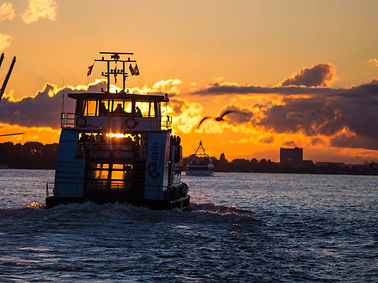
Development of infrastructure, testing & integration (WP4)
This work package focuses on the development of a modular automated charging device to serve as a core building block within the hyper vessel-charging system and the vessel with the ship to shore couplings to the electric vessel and the charging system.
The following reports are, or will be, available. If the reports are classified as confidential, you will receive a comprehensive overview here.
D4.1
Report on Concept design of automated connectors
The focus of Deliverable D4.1 was on the conceptual design of Shore-Ship interfaces, aiming to meet the project's key performance indicators (KPIs) and predefined requirements. The main objectives were to define clear responsibilities for the charging device's functionalities, separate vessel systems and their interface requirements, and design a virtual interface equipment for simulation purposes.
The task begins with an analysis of inputs and constraints from various sources, including Work Package 1, the project's general assembly, and partners' experiences. The state of the art in the automotive and maritime sectors were thoroughly evaluated to identify potential solutions. A proposal, considering requirements and integrating the advantages of existing solutions, is given. This proposal underwent critical analysis with input from partners experienced in the maritime sector. Variants of the initial solution were proposed, highlighting their pros and cons. Virtual 3D simulations are conducted to assess the dynamic compensation capabilities of the new proposals for different vessel types.
Safety aspects related to moving parts and hazardous electrical components were integrated into the design phase. The main results achieved in this task include defining clear boundaries for functional responsibilities, proposing different conceptual contacting systems, conducting virtual simulations of the proposed connecting solutions, and providing additional safety suggestions.
The ultimate goal is to define a new and interoperable connecting interface that surpasses the current state of the art and can be standardized. The Ship Interface, utilizing a simple busbars solution, will offer a highly reliable connection on the ship side, which is crucial for maintaining service availability. The shore connection interface was specified as scalable system to accommodate the port’s requirements.
Overall, the activities within Task 4.1 focused on designing an efficient and reliable Shore-Ship interface for the charging system, ensuring proper communication, separation of functionalities, and safety considerations. The proposed solutions were evaluated through virtual simulations and aim to go beyond existing standards, leading to a standardizable and interoperable interface solution for future applications.

D4.2
Report on Final design
This report presents the final design of the Automated Connection Device (ACD) for the HYPOBATT Multi-MW charging system, providing a comprehensive overview of the technical choices and innovations needed to meet modern maritime charging requirements. The focus is on the contacting system, including the alignment system that compensates for relative movements between shore and ship, and the automated procedure for secure, rapid connections. The design also proposes a reference footprint for both shore and ship sides, optimized for side-connection applications to simplify standardization across ports with varying tidal conditions.
Key objectives include rapid automated connection (<30 seconds), reduced vessel maintenance, modular and interoperable contacting interfaces, and integration of SPE-based charging communication. The ACD design also allows flexibility for charging two independent batteries in parallel, supports larger copper sections to reduce losses, and ensures high reliability under maritime conditions. Several options have been considered, ranging from a simple automated connector to a fully equipped 5 MW system with integrated electrical protections.
Overall, the report provides a state-of-the-art, modular, and standardized solution for high-power maritime charging, building on previous concept studies and paving the way for demonstrator validation and real-world deployment.

D4.3
Design Mock-up
This report details the development status of the Automated Connection Device (ACD) for the HYPOBATT demonstration on Frisia’s fully electric ferry, “Ekat.” Building on previous deliverables (D1.4, D4.1, D3.2, D4.2), it documents the progress in designing sub-components, preliminary testing of prototyped parts, and the remaining work for Task 4.3. The report focuses particularly on the innovative Contacting Interfaces, which integrate high-power and signal lines within a single layout using self-lubricated carbon pad fingers to address temperature, wear, and reliability challenges.
The ACD development aims to support full HYPOBATT power capacity (5 MW), though the Frisia demonstration will operate up to 2.5 MW. It also validates the suitability of the SPE-based charging communication system (with 10Base-T1S/10Base-T1L options) and identifies potential gaps in standardization. The work emphasizes modularity, interoperability, and efficiency, aiming to meet HYPOBATT KPIs while reducing total cost of ownership and maintenance.
Overall, this deliverable provides a clear snapshot of the ACD development for the demonstration phase, highlighting key innovations, challenges, and collaborative problem-solving efforts, with detailed test results to be reported in the upcoming D4.4.

D4.4
Report on integration and internal validation


D4.5
